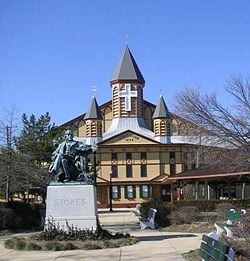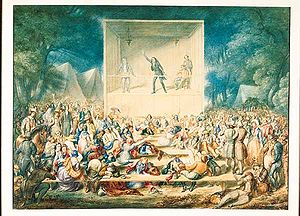Camp meeting
Camp meetings were outdoor religious gatherings that became a prominent feature of the nineteenth century American frontier. Held by various Protestant denominations to minister to the spiritual needs of western, largely un-churched, settlements, they developed into major cultural events as well as revivals.
The first known large camp meetings were led by Reverend the Presbyterian James McGready c. 1797-1800. By the turn of the nineteenth century, the camp meeting movement had spread throughout the American South and West. The movement formed part of the Great Awakening and contributed to the American style of worship and preaching. The English founders of Primitive Methodism took inspiration from the camp meets as a way of holding an extended prayer meeting.
Camp meetings in America
As tens of thousands of Americans began to move west in the late eighteenth century, the lack of churches in the new settlements created a religious vacuum. Not only were there few authorized houses of worship, there were even fewer ordained ministers to fill even the pulpits of these small churches. The "camp meeting" was an innovative response to this situation.
Word of mouth told that there was to be a religious meeting at a certain location. The promise of a skilled preacher and a large gathering of people created a highly attractive event. Due to the still primitive means of transportation of the time, meetings often involved families leaving home for several days, usually camping out near its site, as there were rarely adequate accommodations or the funds necessary to obtain them. The meetings thus represented a kind of vacation from the day-to-day routines of settlements and neighboring farms, as well as a chance to meet old friends, relations, new acquaintances, and even prospective marriage partners in a religiously-based atmosphere.
At a large camp meeting, thousands came from over a large area, some out of sincere religious devotion or interest, others out of curiosity and a desire for a break from the arduous frontier routine. Many in the latter group often became sincere converts as a result of the powerful preaching, singing, and testimonies generated at the meetings.
Freed from their daily routines for the duration of the meeting, unlike traditional religious events these meetings could provide their participants with almost continuous services; once one speaker was finished (often after several hours) another would often rise to take his place. These sorts of meetings were huge contributing factors to what became known as the Second Great Awakening. A particularly large and successful one was held at Cane Ridge, Kentucky in 1801, where the Restoration Movement began to be formalized. They gained wide recognition and a substantial increase in popularity in the aftermath of the American Civil War as a result of the first Holiness movement Camp Meeting in Vineland, New Jersey in 1867. Ocean Grove, New Jersey, founded in 1869, has been called the "Queen of the Victorian Methodist Camp Meetings." At the end of the nineteenth century, believers in Spiritualism also established camp meetings throughout the United States.
In 1815 in what is now Toronto, Ohio, the Rev. J. M. Bray, pastor of the Sugar Grove Methodist Episcopal Church, began an annual camp meeting that, in 1875, became interdenominational upon its purchase by what is now the Hollow Rock Holiness Camp Meeting Association. The association, which still runs the camp, claims that it is the oldest Christian camp meeting in continual existence in the United States.[1]
Camp meetings in America continued to be conducted for many years on a wide scale and some are still held today, primarily by Pentecostal groups but by some other Protestants and Spiritualists as well. The revival meeting is often felt to be a modern-day attempt to recreate the spirit of the frontier camp meeting.
Camp meetings in British Methodism
On Sunday 31 May 1807 the first Camp Meeting was held in England at Mow Cop. The Wesleyan Methodists disapproved and subsequently expelled Hugh Bourne "because you have a tendency to set up other than the ordinary worship" which led eventually to the formation of the Primitive Methodist Church.
Lorenzo Dow brought reports of Camp Meetings from America during his visits to England. Hugh Bourne, William Clowes and Daniel Shoebotham saw this as an answer to complaints from members of the Harriseahead Methodists that their weeknight prayer meeting was too short. Bourne also saw these as an antidote to the general debauchery of the Wakes in that part of the Potteries, one of the reasons why he continued organising Camp Meetings in spite of the opposition from the Wesleyan authorities.
The pattern of the Primitive Methodist Camp Meeting was as a time of prayer and preaching from the Bible. In the first Camp Meeting, 4 separate "preaching stations" had been set up by the afternoon, each with an audience, while in between others spent the time praying. Their emphasis on the Bible is a clear distinction from the spiritualist strand of American camp meetings.
From May 1807 to the establishing of Primitive Methodism as a denomination in 1811, a series of 17 Camp Meetings was held.[2] There were a number of different venues beyond Mow Cop, including Norton-in-the-Moors during the Wakes in 1807 (Hugh Bourne's target venue), and Ramsor in 1808.
After Hugh Bourne and a significant number of his colleagues, including the Standley Methodist Society, had been put out of membership of the Burslem Wesleyan Circuit, they formed a group known as the Camp Meeting Methodists until 1811 when they joined with the followers of William Clowes, the "Clowesites".
Camp Meetings were a regular feature of Primitive Methodist life throughout the 19th century,[3] and still have existence in other forms today. The annual late May Bank Holiday weekend meetings at Cliff College[4] are one example, with a number of tents around the site, each with a different preacher.
Notes
- ↑ Kiaski, Janice. Holiness at Hollow Rock. HollowRock.org. Retrieved 2007-07-26.
- ↑ H B Kendall, “The Origin and History of the Primitive Methodist Church”, (1906 for the 1907 Camp Meeting Centenary), p. 89 ISBN 1901670-49-X ISBN 9781901670-49-3 (EAN-13 format)
- ↑ Continued mention in Circuit Plans and the Minutes of Circuit Meetings
- ↑ Cliff College is a Methodist training college in Derbyshire. The meetings are an annual attraction for many Methodists.
ReferencesISBN links support NWE through referral fees
- Paul Gillespie and his students (editors), Foxfire 7, Anchor Books, New York 1980, ISBN 0-385-15244-2
- Moore, William D., 1997. "'To Hold Communion with Nature and the Spirit-World:' New England's Spiritualist Camp Meetings, 1865-1910." In Annmarie Adams and Sally MacMurray, eds. Exploring Everyday Landscapes: Perspectives in Vernacular Architecture, VII. Knoxville: University of Tennessee Press. ISBN 0-87049-983-1.
- George Rawlyk The Canada Fire: Radical Evangelicalism in British North America, 1775-1812. McGill-Queen's UP, 1994.
- The 20th century American composer Charles Ives used the Camp Meeting phenomenon as a metaphysical basis for his Symphony No. 3 (Ives). Although the piece wasn't initially performed until almost 40 years after its composition in 1946, it did succeed in winning the Pulitzer Prize the following year in 1947.
External links
- Christian Camp and Conference Association
- Journal of Methodist itinerant Nathan Bangs (1778–1862) recounting the first camp meeting held in Upper Canada in 1805
Credits
New World Encyclopedia writers and editors rewrote and completed the Wikipedia article in accordance with New World Encyclopedia standards. This article abides by terms of the Creative Commons CC-by-sa 3.0 License (CC-by-sa), which may be used and disseminated with proper attribution. Credit is due under the terms of this license that can reference both the New World Encyclopedia contributors and the selfless volunteer contributors of the Wikimedia Foundation. To cite this article click here for a list of acceptable citing formats.The history of earlier contributions by wikipedians is accessible to researchers here:
The history of this article since it was imported to New World Encyclopedia:
Note: Some restrictions may apply to use of individual images which are separately licensed.


